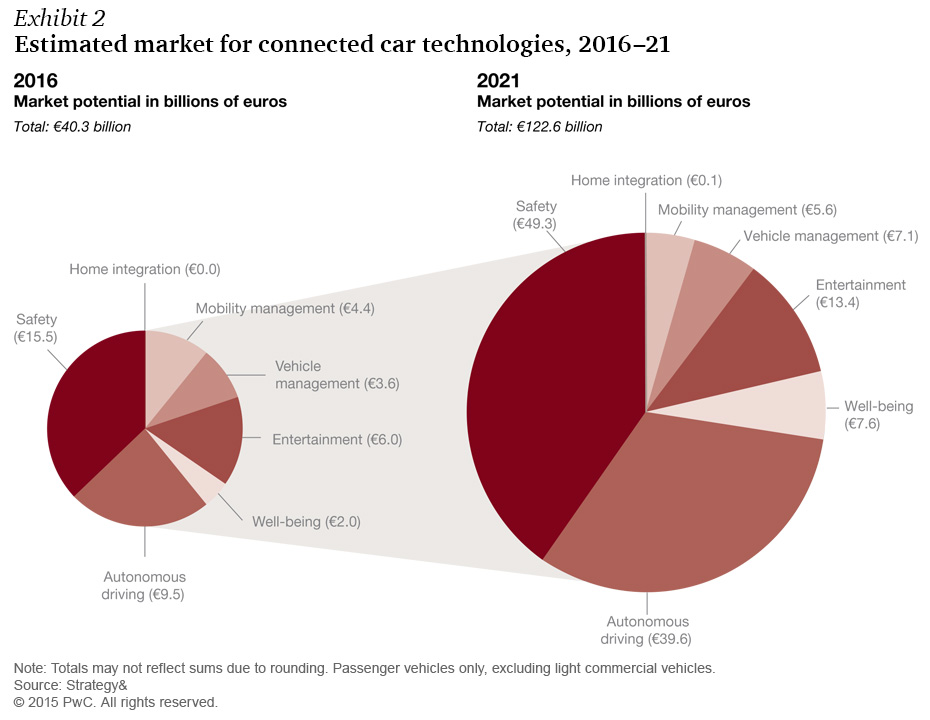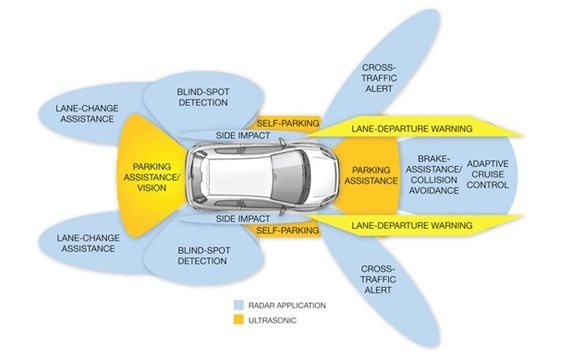Enhancing safety is top priority for all the automotive organizations. Safety has always been at the core of automotive design philosophies. Electronic safety systems have become more intelligent and effective. In addition to anti-braking systems and stability controls, vehicles have many advanced safety features that can essentially prevent a head-on-collision, prepare and rescue passengers from sudden impact and avoid sideswipe.
The estimated market for connected car technologies reflects the importance provided to safety systems as shown in the image below.
Image Courtesy- PwC
Safety systems that were once a luxury feature have become mandatory in most of the automotive vehicles. Interestingly, regulators and manufacturers are establishing defacto safety standards and guidelines for vehicles. With innovation driving the automotive industry, manufacturers are always in the race to introduce safety systems that are ahead of competition.
Apart from introducing a number of safety systems, both automotive organizations and suppliers are also improving the passive safety features of vehicles. They make use of materials such as high strength steel and carbon fibre composites. Utilization of these materials becomes more effective by adopting aerodynamic and fail-safe designs. These designs can absorb much of the energy during a crash before it reaches the passenger area. One of the fine examples would be the usage of high-strength steel to help protect passengers in front and side impacts.
Image courtesy: Davis Body Shop
“As part of a unique industry government consortium, American motorists will soon find virtually every car, truck and crossover on the market equipped with a breakthrough safety system called Automatic Emergency Braking.” Source
List of next-gen safety systems offered by automotive manufacturers includes:
1. Adaptive cruise control:
This system helps to maintain a safe distance between the following vehicles. The laser and sensor systems can adjust cruising speeds to allow a safe distance limit. It can pre-configurable based on the preferences of drivers.
2. Forward collision prevention systems:
The cameras, sensors and lasers present in the front and rear of the vehicles helps in collision avoidance. For example, the front mounted cameras with augmented reality provide drivers early hazards warnings in bumper-to-bumper city traffic.
3. Blind spots alert systems:
These systems can detect objects in driver’s blind spots or the oncoming rear traffic. In this system, a number of images are captured and processed to detect any blind spots around the vehicles. The blind spots are conveyed to drivers by triggering flash lights at side mirrors and also they provide notifications through sound alerts.
4. Upgradable open architecture safety systems
The safety systems of premium vehicles now come with upgradable open architecture. It can include and integrate any future developments and innovations.
5. Haptic feedback systems:
Crash warnings or brake alerts are provided using haptic feedback to steering wheel or vibrations to seats. The beep sound in the midst of nowhere can immediately alert driver in case of distance between the following vehicles or oncoming vehicles is very less.
Increasingly most premium vehicles are looking at advancing their safety features to include brake assist, evasive steering assist, remote parking assist, auto-braking, and lane warning departure systems.
According to ABI research, “technological improvements in computers, smartphones, wireless communications and the cloud have converged to advance safety for connected consumers. Connectivity and the internet are changing the world of autos, and more change is coming. The percentage of new passenger cars globally shipping with factory-installed telematics is believed to have increased from nearly 10 percent in 2010 to 62 percent in 2016.”
Johann Greska, or Johnny, is Strategic Client Partner, QuEST Global. Johnny joined QuEST in 2015 after QuEST acquired EDF Engineering and Design im Fahrzeugbau GmbH. At EDF, he held firstly the head of development position and became afterwards the Strategic Client Partner for BMW. Johnny holds a degree in Automotive Engineering from the Technical University, Munich (Germany). Quest, is the global engineering partner for automotive OEMs, considers safety systems as one of the most significant components of vehicles.
Disclaimer : The opinions expressed within this article are those of the author. The article does not reflect the views of Motoroids and Motoroids does not assume any responsibility or liability for the same.



